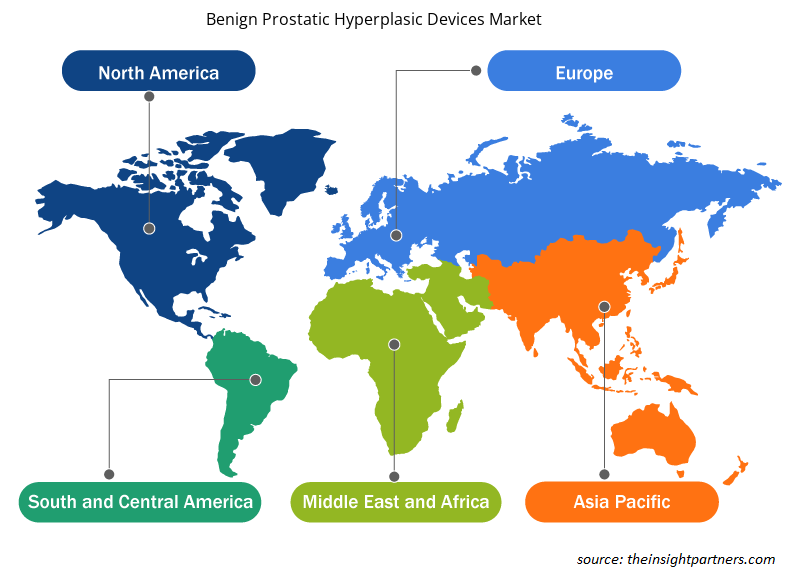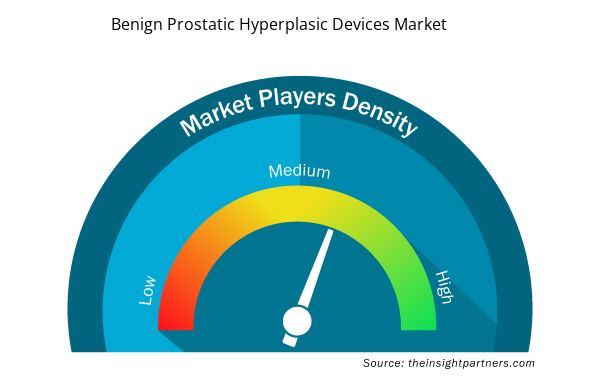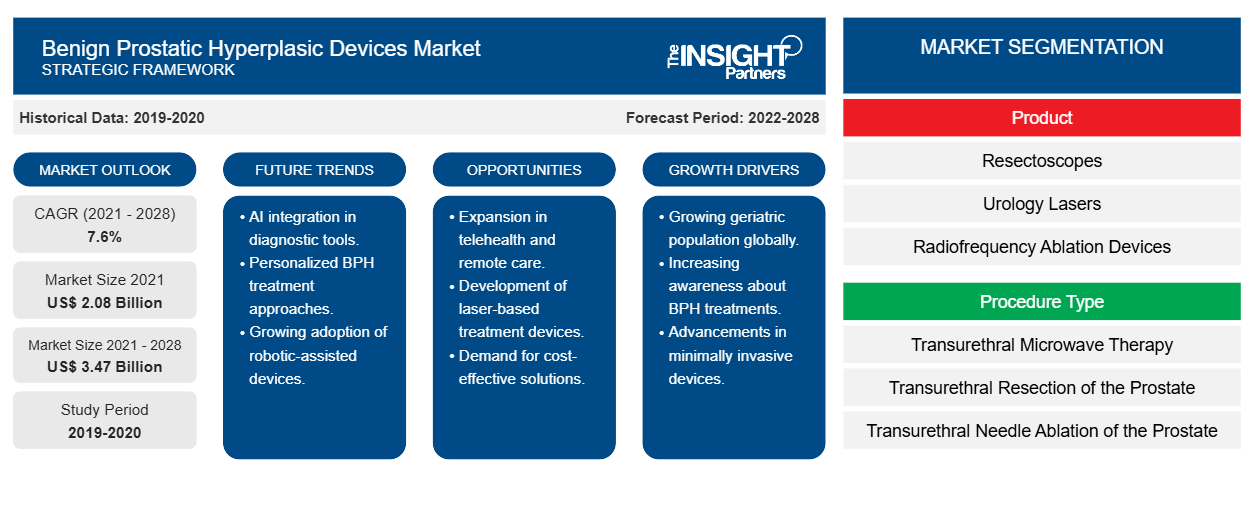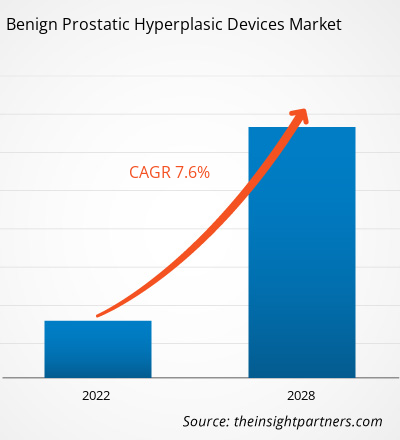[研究报告] 前列腺增生设备市场预计将从 2021 年的 20.7878 亿美元增长到 2028 年的 34.6731 亿美元;预计 2022 年至 2028 年的复合年增长率为 7.6%。
良性前列腺增生 (BPH) 是一种由前列腺细胞过度生长引起的前列腺增大。BPH 是一种良性(非癌性)前列腺疾病。非癌性疾病通常不会致命,也不会扩散(转移)到其他身体部位。BPH 不会增加患前列腺癌的风险;除非出现症状,否则 BPH 不被视为健康问题。几乎所有男性在 70 岁之前都会出现前列腺增大。年龄增长、腹部脂肪增多(也称为腹部肥胖)和运动不足都会增加患 BPH 的风险。
前列腺增生治疗设备市场 按产品、治疗类型、最终用户和地域进行细分。按地域划分,市场大致分为北美、欧洲、亚太地区、中东和非洲以及南美和中美洲。本报告提供了对市场的深入分析和见解,重点关注市场趋势、市场动态和全球领先市场参与者的竞争分析等参数。
定制此报告以满足您的需求
您可以免费定制任何报告,包括本报告的部分内容、国家级分析、Excel 数据包,以及为初创企业和大学提供优惠和折扣
- 获取此报告的关键市场趋势。这个免费样品将包括数据分析,从市场趋势到估计和预测。
市场洞察
良性前列腺增生的患病率不断增加,风险因素也不断增加,用于 BPH 治疗研究的投资、资金和补助金不断增加,推动了良性前列腺增生设备市场的发展。
根据美国国家生物技术信息中心(NCBI)的数据,BPH 是老年男性中最常见的疾病之一,也是下尿路症状(LUTS)的主要原因。40 岁以后,BPH 的发病率上升,到 90 岁时达到 60% 的峰值。根据尸检研究,BPH 的组织学发病率在男性 40、60 和 90 岁时分别为 8%、50% 和 80%。在欧洲、美国和亚洲进行的观察性研究也表明,高龄是临床 BPH 发病和进展的危险因素。根据 Krimpen 和巴尔的摩老龄化纵向研究的统计数据,老年男性的前列腺每年以 2.0% 至 2.5% 的速度增长。前列腺持续增大是罹患 LUTS 的风险因素,而较大的前列腺与良性前列腺增大 (BPE) 有关,而良性前列腺增大会引发罹患临床 BPH 和尿失禁的风险。
根据 NCBI 数据,肥胖增加与前列腺体积呈正相关。在许多研究组中,体重、体重指数 (BMI) 和腰围与前列腺体积呈正相关。此外,流行病学数据显示,肥胖可能会增加 BPH 手术和开始 BPH 治疗的必要性。
据美国男性健康杂志(AJMH)报道,2019年全球BPH新发病例1126万,因BPH导致的残疾寿命年(YLD)186万。1990年至2019年期间,全球BPH发病率增加了105.7%,YLD增加了110.6%。在此期间,全球绝对发病率和YLD数大幅增加,主要原因是人口增加和老龄化。根据泌尿外科基金会的估计,在英国,BPH的患病率从50-60岁男性的50%上升到80岁及以上男性的90%。一些男性会突然出现急性尿潴留,即无法排尿。 BPH 的治疗方案包括经尿道前列腺切除术 (TURP)、开放式前列腺切除术等手术,以及经尿道针消融术 (TUNA) 等微创治疗。在射频消融术、激光治疗和植入物等微创治疗中,会使用良性前列腺增生装置。因此,良性前列腺增生患病率的增加和风险因素的增加正在推动对良性前列腺增生装置的需求。
产品洞察
根据产品,前列腺增生设备市场细分为电切镜、射频消融设备、泌尿科激光器、前列腺支架和植入物。电切镜部分很可能在 2022 年占据最大的市场份额。然而,由于医生的需求量很大,以及市场参与者在产品发布和扩展方面的积极性不断提高,预计泌尿科激光器部分将在预测期内实现最高的复合年增长率。
程序类型洞察
根据手术类型,前列腺增生器械市场细分为经尿道微波治疗、经尿道前列腺切除术、经尿道前列腺针消融术、激光手术、尿道提升手术等。2022 年,经尿道前列腺切除术细分市场可能占据市场最大份额。此外,由于该细分市场具有直观、手动接触前列腺、立即去除多余组织的能力以及经尿道前列腺切除术 (TURP) 与其他手术相结合的能力,预计该细分市场的需求将在 2022 年至 2028 年期间以最快的复合年增长率增长。
最终用户洞察
根据最终用户,良性前列腺增生设备市场分为医院、诊所、门诊手术中心和其他。2022 年,医院部门可能会占据最大的市场份额。此外,由于治疗成本较低、交通便利、等待时间短且灵活性强的诊所数量增加,预计诊所部门的需求将在 2022 年至 2028 年期间以最快的复合年增长率增长。
产品发布和批准等有机发展是全球良性前列腺增生设备市场参与者高度采用的策略。以下列出了一些近期的关键市场发展:
- 2022 年 4 月,Teleflex Incorporated 在日本推出了用于治疗 BPH 或前列腺肥大的 UroLift 系统。该系统在推出后立即可供购买。
- 2020 年 4 月,奥林巴斯宣布其非手术医疗设备 iTind 获批用于 BPH 的微创手术。这是一种临时尿道开口装置,已获得 FDA 的 De Novo 分类,属于 II 类医疗设备。
良性前列腺增生设备市场 - 细分
全球良性前列腺增生设备市场细分为产品、手术类型、最终用户和地域。根据产品,市场细分为电切镜、射频消融设备、泌尿科激光器、前列腺支架和植入物。根据手术类型,市场细分为经尿道微波治疗、经尿道前列腺切除术、经尿道前列腺针消融术、激光手术、尿路提升手术和其他。根据最终用户,市场分为医院、诊所、门诊手术中心和其他。根据地域,市场细分为北美、欧洲、亚太地区、中东和非洲以及南美和中美洲。
良性前列腺增生设备市场报告范围
良性前列腺增生设备市场区域洞察
Insight Partners 的分析师已详尽解释了预测期内影响前列腺增生设备市场的区域趋势和因素。本节还讨论了北美、欧洲、亚太地区、中东和非洲以及南美和中美洲的前列腺增生设备市场细分和地理分布。

- 获取良性前列腺增生设备市场的区域特定数据
良性前列腺增生设备市场报告范围
| 报告属性 | 细节 |
|---|---|
| 2021 年市场规模 | 20.8亿美元 |
| 2028 年市场规模 | 34.7 亿美元 |
| 全球复合年增长率(2021 - 2028) | 7.6% |
| 史料 | 2019-2020 |
| 预测期 | 2022-2028 |
| 涵盖的领域 | 按产品
|
| 覆盖地区和国家 | 北美
|
| 市场领导者和主要公司简介 |
|
市场参与者密度:了解其对商业动态的影响
良性前列腺增生设备市场正在快速增长,这得益于终端用户需求的不断增长,而这些需求又源于消费者偏好的不断变化、技术进步以及对产品优势的认识不断提高等因素。随着需求的增加,企业正在扩大其产品范围,进行创新以满足消费者的需求,并利用新兴趋势,从而进一步推动市场增长。
市场参与者密度是指在特定市场或行业内运营的企业或公司的分布情况。它表明在给定市场空间中,相对于其规模或总市场价值,有多少竞争对手(市场参与者)存在。
在良性前列腺增生设备市场运营的主要公司有:
- 卡尔史托斯股份两合公司
- 理查德沃尔夫有限公司
- 奥林巴斯公司
- Urologix有限责任公司
- 波士顿科学公司
免责声明:上面列出的公司没有按照任何特定顺序排列。

- 了解良性前列腺增生设备市场顶级关键参与者概况
良性前列腺增生设备市场 - 公司简介
- 卡尔史托斯股份两合公司
- 理查德沃尔夫有限公司
- 奥林巴斯公司
- Urologix有限责任公司
- 波士顿科学公司
- 蝴蝶
- TELEFLEX 公司
- OmniGuide 控股公司
- 聚合激光技术
- 普罗阿克
- 奥林巴斯公司
- 历史分析(2 年)、基准年、预测(7 年)及复合年增长率
- PEST 和 SWOT 分析
- 市场规模价值/数量 - 全球、区域、国家
- 行业和竞争格局
- Excel 数据集


- Batter and Breader Premixes Market
- Single Pair Ethernet Market
- Social Employee Recognition System Market
- Unit Heater Market
- Non-Emergency Medical Transportation Market
- Personality Assessment Solution Market
- Semiconductor Metrology and Inspection Market
- Fishing Equipment Market
- Aerospace Forging Market
- Military Rubber Tracks Market

Report Coverage
Revenue forecast, Company Analysis, Industry landscape, Growth factors, and Trends

Segment Covered
This text is related
to segments covered.

Regional Scope
North America, Europe, Asia Pacific, Middle East & Africa, South & Central America

Country Scope
This text is related
to country scope.
常见问题
Benign prostatic hyperplasia (BPH) is a prostate enlargement caused by excessive cell growth in the prostate. BPH is a benign (non-cancerous) prostate condition. Non-cancerous conditions are not usually fatal and do not spread (metastasize) to other body parts. BPH doesn't raise the risk of prostate cancer; unless it manifests symptoms, BPH isn't considered a health issue. Almost all men will have some prostate growth by the age of 70. Getting older, having more belly fat (also known as abdominal obesity), and not getting enough exercise to raise the risk of developing BPH.
The factors that are driving and restraining factors that will affect the benign prostatic hyperplasic devices market in the coming years. Factors such as the rise in the prevalence of benign prostatic hyperplasia amongst men, along with increasing risk factors and rise in investments, funds, and grants for research in BPH treatment. However, less awareness about prostate health among men will hamper the market growth.
The global benign prostatic hyperplasic devices market based on product is resectoscopes, radiofrequency ablation devices, urology laser, prostatic stents, and implants. The resectoscopes segment is likely to hold the largest share of the market in 2022. However, the urology lasers segment is anticipated to register the highest CAGR of 8.4% in the market during the forecast period.
The benign prostatic hyperplasic devices market majorly consists of the players such as KARL STORZ SE & Co. KG; Richard Wolf GmbH; Olympus Corporation; Urologix, LLC.; Boston Scientific Corporation; Butterfly; TELEFLEX Incorporated; OmniGuide Holdings, Inc.; Convergent Laser Technologies; ProArc; and Olympus Corporation.
Trends and growth analysis reports related to Life Sciences : READ MORE..
The List of Companies - Benign Prostatic Hyperplasic Devices Market
- KARL STORZ SE & Co. KG
- Richard Wolf GmbH
- Olympus Corporation
- Urologix, LLC.
- Boston Scientific Corporation
- Butterfly
- TELEFLEX Incorporated
- OmniGuide Holdings, Inc.
- Convergent Laser Technologies
- ProArc
- Olympus Corporation
The Insight Partners performs research in 4 major stages: Data Collection & Secondary Research, Primary Research, Data Analysis and Data Triangulation & Final Review.
- Data Collection and Secondary Research:
As a market research and consulting firm operating from a decade, we have published and advised several client across the globe. First step for any study will start with an assessment of currently available data and insights from existing reports. Further, historical and current market information is collected from Investor Presentations, Annual Reports, SEC Filings, etc., and other information related to company’s performance and market positioning are gathered from Paid Databases (Factiva, Hoovers, and Reuters) and various other publications available in public domain.
Several associations trade associates, technical forums, institutes, societies and organization are accessed to gain technical as well as market related insights through their publications such as research papers, blogs and press releases related to the studies are referred to get cues about the market. Further, white papers, journals, magazines, and other news articles published in last 3 years are scrutinized and analyzed to understand the current market trends.
- Primary Research:
The primarily interview analysis comprise of data obtained from industry participants interview and answers to survey questions gathered by in-house primary team.
For primary research, interviews are conducted with industry experts/CEOs/Marketing Managers/VPs/Subject Matter Experts from both demand and supply side to get a 360-degree view of the market. The primary team conducts several interviews based on the complexity of the markets to understand the various market trends and dynamics which makes research more credible and precise.
A typical research interview fulfils the following functions:
- Provides first-hand information on the market size, market trends, growth trends, competitive landscape, and outlook
- Validates and strengthens in-house secondary research findings
- Develops the analysis team’s expertise and market understanding
Primary research involves email interactions and telephone interviews for each market, category, segment, and sub-segment across geographies. The participants who typically take part in such a process include, but are not limited to:
- Industry participants: VPs, business development managers, market intelligence managers and national sales managers
- Outside experts: Valuation experts, research analysts and key opinion leaders specializing in the electronics and semiconductor industry.
Below is the breakup of our primary respondents by company, designation, and region:

Once we receive the confirmation from primary research sources or primary respondents, we finalize the base year market estimation and forecast the data as per the macroeconomic and microeconomic factors assessed during data collection.
- Data Analysis:
Once data is validated through both secondary as well as primary respondents, we finalize the market estimations by hypothesis formulation and factor analysis at regional and country level.
- Macro-Economic Factor Analysis:
We analyse macroeconomic indicators such the gross domestic product (GDP), increase in the demand for goods and services across industries, technological advancement, regional economic growth, governmental policies, the influence of COVID-19, PEST analysis, and other aspects. This analysis aids in setting benchmarks for various nations/regions and approximating market splits. Additionally, the general trend of the aforementioned components aid in determining the market's development possibilities.
- Country Level Data:
Various factors that are especially aligned to the country are taken into account to determine the market size for a certain area and country, including the presence of vendors, such as headquarters and offices, the country's GDP, demand patterns, and industry growth. To comprehend the market dynamics for the nation, a number of growth variables, inhibitors, application areas, and current market trends are researched. The aforementioned elements aid in determining the country's overall market's growth potential.
- Company Profile:
The “Table of Contents” is formulated by listing and analyzing more than 25 - 30 companies operating in the market ecosystem across geographies. However, we profile only 10 companies as a standard practice in our syndicate reports. These 10 companies comprise leading, emerging, and regional players. Nonetheless, our analysis is not restricted to the 10 listed companies, we also analyze other companies present in the market to develop a holistic view and understand the prevailing trends. The “Company Profiles” section in the report covers key facts, business description, products & services, financial information, SWOT analysis, and key developments. The financial information presented is extracted from the annual reports and official documents of the publicly listed companies. Upon collecting the information for the sections of respective companies, we verify them via various primary sources and then compile the data in respective company profiles. The company level information helps us in deriving the base number as well as in forecasting the market size.
- Developing Base Number:
Aggregation of sales statistics (2020-2022) and macro-economic factor, and other secondary and primary research insights are utilized to arrive at base number and related market shares for 2022. The data gaps are identified in this step and relevant market data is analyzed, collected from paid primary interviews or databases. On finalizing the base year market size, forecasts are developed on the basis of macro-economic, industry and market growth factors and company level analysis.
- Data Triangulation and Final Review:
The market findings and base year market size calculations are validated from supply as well as demand side. Demand side validations are based on macro-economic factor analysis and benchmarks for respective regions and countries. In case of supply side validations, revenues of major companies are estimated (in case not available) based on industry benchmark, approximate number of employees, product portfolio, and primary interviews revenues are gathered. Further revenue from target product/service segment is assessed to avoid overshooting of market statistics. In case of heavy deviations between supply and demand side values, all thes steps are repeated to achieve synchronization.
We follow an iterative model, wherein we share our research findings with Subject Matter Experts (SME’s) and Key Opinion Leaders (KOLs) until consensus view of the market is not formulated – this model negates any drastic deviation in the opinions of experts. Only validated and universally acceptable research findings are quoted in our reports.
We have important check points that we use to validate our research findings – which we call – data triangulation, where we validate the information, we generate from secondary sources with primary interviews and then we re-validate with our internal data bases and Subject matter experts. This comprehensive model enables us to deliver high quality, reliable data in shortest possible time.


 获取此报告的免费样本
获取此报告的免费样本